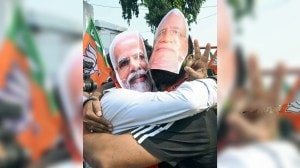Sailing through Chinese waters
If Defence Minister George Fernandes’s speech at National Defence University is any indication, then both India and China have candidly...

If Defence Minister George Fernandes’s speech at National Defence University is any indication, then both India and China have candidly discussed impediments to improvement in bilateral ties. His Beijing speech conveys that India has raised its concern over China supplying ‘‘sensitive technology’’ to Pakistan and the latter must have expressed its concerns over New Delhi’s moves in the Indian Ocean in the context of regional stability.
It is understood that Beijing is interested in forging ties with the Indian Navy in a bid to keep ‘‘extraneous’’ influences out of the Indian Ocean. With the People’s Liberation Army’s focus shifting from land to sea-based forces, China is concerned about the deepening naval cooperation between New Delhi and Washington. Even though India-US joint patrolling of the Malacca Straits is rather symbolic, Beijing has been concerned since US Pacific Fleet warships docked at Indian ports for ‘‘rest and replenishment’’ during the Afghan campaign.
Over the years, Beijing has been adding muscle to PLA Navy by purchasing state-of-the-art Soverymenny class-guided missile destroyers from Russia. China already has two such destroyers and has ordered two more from Russia, besides building an aircraft carrier. South Block sources said that the recent acquisitions by the PLA Navy show its desire to acquire a capability to project force in the Indian Ocean in the context of energy security. It is not without reason that China has invested heavily in building Gwadar port in Pakistan as well as upgrading other sea ports such as Pasni and Omara.
Beijing has been keenly watching the Indian Navy’s strategy through joint exercises with navies of Vietnam and South Korea in South China sea in the new . It was rather alarmed at the Indian Navy’s ambitious plans — made during the tenure of Admiral Sushil Kumar — to acquire the capability to send expeditionary forces by 2010. The establishment of the tri-service command at Andamans and Nicobar Islands by the Indian armed forces has aggravated Beijing’s threat perception as the island territories are virtually sitting on the sea trade route to South China Sea and North Asia.
However, rather than view India as a rival, Beijing is signalling cooperation in the naval field and is not averse to the idea of joint exercises with Indian Navy under the bi-annual Milan exercise series held off the East Coast. New Delhi’s assessment is that Beijing is conveying that it could use its influence with Malaysia, Indonesia and Myanmar — which are concerned at Indo-US joint patrolling — to make things easier for the Indian Navy.
It is learnt that while India will discuss its naval presence in the Indian Ocean with Beijing but will not undertake any commitments given China’s ‘‘all weather’’ relationship with Pakistan. This is also because New Delhi believes that its strategic interests stretch from Malacca Straits to the Gulf of Aden and wants to project its dominance in the Indian Ocean. Pursuing its interests, New Delhi has plans to upgrade its naval fleets, including the acquisition of nuclear submarines, in a bid to acquire blue water capability.
By discussing all the contentious issues with new Chinese leadership, Fernandes has prepared the stage for the forthcoming visit of Prime Minister Atal Behari Vajpayee to Beijing. It seems that rather than focus on solving the contentious issues first, Vajpayee will use the growing bilateral trade as a driver to improve ties with Beijing.



- 01
- 02
- 03
- 04
- 05




























